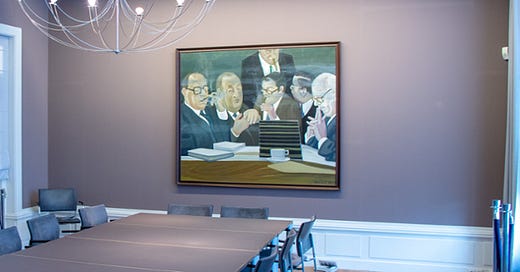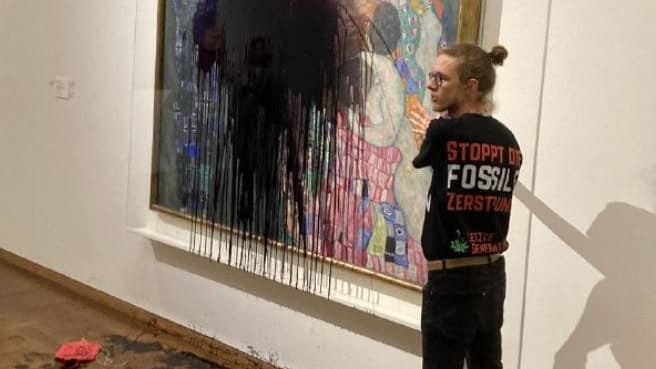Last week at the renowned Leiden University in The Netherlands a painting in one of the law faculty’s meeting rooms was removed after a student had complained. The dean of the faculty responded by not only deciding to remove the said painting, but she went on to support the removal citing it was about time and went on Twitter to confirm that immediate action was taken. The problem? The depiction of white men smoking was creating feelings of being ‘unrepresented’ and this fuelled the complaint. In other words, the inclusivity argument was used to exclude art that was somehow deemed offensive as it failed to represent other people who used the meeting room.
A media storm ensued - the Dutch are really good at this - which in turn resulted in a closer analysis of the painting in question. It depicted the old board of the university and to highlight the diversity angle it was the first ones to be democratically elected and one of its members, Professor Dolf Cohen had gone into hiding during the war in order to survive the Holocaust. It represented the state of affairs in the 1970s. And yes, it was made during a period when practically every meeting took place in a haze of smoke. The painter, the now ninety year old Rein Dool reacted quite furiously and pointed to the fact that works of art generally represent the period in which they were created. By that logic we should be removing Rembrandt’s Night Watch, argued Dool. Dutch writer and TV personality Heleen van Royen added some irony to it all by highlighting her discomfort with one of Van Gogh’s classic paintings.
So moving paintings around is one thing, the wanton physical attacks on them is quite another. And that has been happening at an increasing pace where climate activists attack famous works of art which are splashed with paint, soup or whatever fluid substance is on hand. The moistures used so far do not appear to be damaging the art, but it is of course a matter of time before they do. Or when some nutter decides that real damage is required to create some more shock value. The latest attack took place in Vienna where the group ‘Last Generation Austria’ poured an oily liquid over one of Gustav Klimt’s paintings. In Vancouver recently it was a painting by Emily Carr that had to endure a dose of maple syrup. The absurdity of the attack was of course underlined by the fact that Carr herself was an environmentalist avant-la-lettre.
Art somehow is always one of the key areas to come under scrutiny once revolutionary movements start to progress their agenda. Getting rid of what is old and traditional is the easy and obvious route of attack. It gets you attention and you fulfil the promise of healing and renewal all at the same time. Damaging art is of course a problem in and of itself, but once these movements gain power they tend to convert these missionary instincts into totalitarian control. In Hitler’s Germany things got started with burning books by writers that were offensive and counter to Nazi culture, it continued with a full scale redefinition of what art was (recall ‘entartete kunst’) and it ended in the gas chamber. More recently it was Mao’s Cultural Revolution that sought to destroy the ‘Four Olds’ which was a pretty much a licence to raze anything and everything that represented old culture. The damage to China’s cultural treasures was untold.
You may argue that bringing in Mao and Hitler into somewhat frivolous engagements with works of art in our times is a stretch, but it is not. If we have leading members of faculties signalling to students that removal of both historic and harmless cultural expressions is desirable then we have some deep problems. The first one is the obvious one about where such actions will eventually end, or are they an indication that we can continue the cultural cleansing in other areas too? Street names next maybe? Edit and ban movies? And secondly, if leading faculty members buy into this and create learning moments for, in this case, the next generation of legal professionals, what does that tell us about the future to come? Are we raising an elite that thinks nothing of stamping out what they have been told is either undesirable or unwelcoming in today’s world?
China’s Cultural Revolution has always lacked proper attention in western media. When I grew up in the 1970s it was seen as a commendable fight for a better world and Mao was revered under left-wing intelligentsia. As we know now, it was a period of intimidation, extreme terror and bloodbaths which wasted an entire generation. It is unlikely that we fall into such an abyss again or have a replay of Nazism on our shores. But it may well be that the same sort of emotions are making their way into our society under the guise of a more inclusive environment and better climate. A cleansing of the past is instrumental in any revolutionary creed. Once these impulses are given free rein they will penetrate every aspect of society until they metastasize into real violence.
The painting in Leiden is back following the uproar and museums are stepping up their security efforts. It is an incredibly sad spectacle to see how treasures of our past are treated as disposable waste in a political and cultural war.





I hope at least Greta is condemning this sort of stuff. Wacked leftists (and in the US wacked rightists too)....the world certainly seems to be fomenting something.